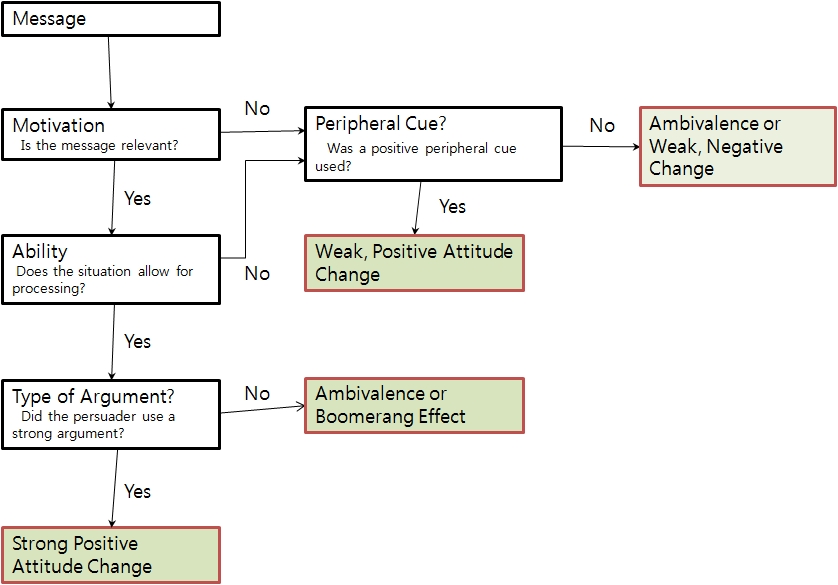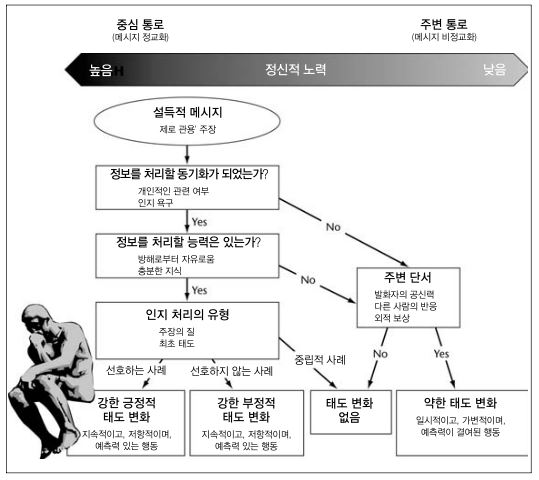Table of Contents
Elaboration Likelihood Model
? __Elaboration Likelihood Model (ELM)__ : posits two possible routes or methods of influence: (1) centrally routed messages, and (2) peripherally routed messages. Each route targets a different audience. ELM focuses on the importance of understanding audience members before creating a persuasive message. : ELM depicts persuasion as a process in which the success of influence depends on the way the receivers make sense of the message.
Central route
- Also referred to elaborated route.
- Centrally routed message include: a wealth of information, raitonal arguments, and evidence to support a particular conclusion.
- e.g., Political messages (during each election season) are usually filled with elaborated and presumably rational information regarding the candidate's viewpoints, platform,and political history.
- Centrally routed messages are much more likely to create long-term change for the recipient than are peripheral messages. However, the term, centrally routed is a subjective term, which means that not all individuals are capable of receiving centrally routed messages.
- Centrally routed messages are successful in long-term change only when two factors are met:
- The target must be highly motivated to process all of the information being give;
- e.g., If you are not willing to sit for two hours straight for the televised political debate between presidental candidates, then ELM suggests that you do not have the motivation required to process an elaborated messsage.
- The target must be able to process the message cognitively.
- You are willing to sit in front of television set for two straight hours. But, you do not understand the terms and ideas exchanged between the candidates in the debates, the effects would not happen.
- both motivation and ability are crucial factors for the elaborated message.
중요한 가정
- 정교화 동기
- 정교화 능력
Types of Elaborated Aruguments
Elaborated argument (message) can be measured as strong, neutral, weak argument.
Strong arguments create a positive cognitive response. The ideas in the message (sender's) are harmonious with those in the receiver's mind.
- This type of argument inoculate the audience against counter-persuasion, and
- create long-term attitude change that would result in predictable behavior.
- Repetition is thought to have a reinforcing effect – enhancing the persuasive effect of strong arguments.
Neutral arguments generate a noncommittal cognitive response from the receiver. No attitudes change would occur.
Weak arguments produce a negative cognitive response to the message. This negative response may have a reverse effect, reinforcing the opposite point of view that the receiver holds.
Peripheral route
- When motivation or ability (to process information) is missing from the target audience, the persuader (advertiser) can use the peripheral route to persuasion. Peripheral messages rely on a receiver's emotional involvement and persuade through more superficial means.
- e.g., Political campaign . . . . It is common for presidential candidates to air 30-second commercials that focus on portraying feel-good images of their “family values,” patriotism, character, and likability.
- Also, some candidates use celebrity endorsements, such as having a famous person or group give public support. For example, a number of NBA players publicly supported Bill Bradley during his 2000 run for presidential nomination.
- When audience is unmotivated or unable to process an elaborated message, persuaders should focus on quick and easy ways to produce change. But, this method leads only to short-term change, if any change at all.
- 매직존슨의 커밍아웃과 AIDS에 대한 태도
- 유명인 = 매직존슨
- 지속적인 태도 변화가 이루어지지 않음
- 연구대상지원: 80 - 30 (80 - 40 여성)
Seven types of peripheral cue uses
- Authority: The persuader uses authority (or authority figure) to convince the audience to accept the beliefs or behaviors. Parent may use this strategy – “Clean up the room because I said so!” This message would work for a while; but may not have a long-term effect.
- Commitment: This strategy focuses on a person's dedication to a product, social cause, group affiliation, political party, etc. Usually foot-in-the-door tactic is used as a sequential procedure to change one's attitudes and behaviors. The persuader may ask you
- Wearing a badge → Putting campaign sign in your yard → Asking to make a donation or to host a reception, etc.
- Cheep and dirty: 북극곰 보호와 관련된 스티커를 보호하자는 쪽에 붙이도록 권유하고 성공하면 성금을 유도함
- Contrast: This tactic usually sets up uneven points of comparison; then ask the receiver to choose the one that persuader wants. Car sales-person may give you an expensive car that you cannot afford, first. Then, give another car that you can afford. This will give you lean toward the latter model of the car.
- 비싼 것을 두개 보여 주고 팔만한 자동차를 선택하도록 함
- Liking: Liking focus on affinity toward a person, place, or object. Advertise company uses Britney Spears to sell Pepsi or SonyoSidae to sell cellular phone.
- PPL 등이 그것
- Reciprocity: This strategy presents give-and-take relationship. In supermarket, you often see “Buy this knife in the next 10 minutes, we will give you a free cutting board.” – If you do this, we will give you a freebie.
- Scarcity: This tactic makes people worried about something. “They will be all gone in the next 10 minutes. Hurry up! Call me now. The size that fits you will disappear soon. You need to pick up the phone right now.” – Announcement in a shopping channel uses this tactic.
- Social proof: This tactic uses a kind of peer-pressure. The idea of “Everyone is doing it.” work really well for the teen-age.
- 호혜성: 나한테 빚졌다.
- 일관성: 우리는 항상 이렇게 해 왔어
- 사회적증명: 다른 사람도 다하고 있어
- 호감: 날 사랑한다면 내 생각도 좋아해 줘
- 권위: 단지 내가 그렇게 하라고 하니까 해야 해
- 희귀성: 물건이 몇 개 남지 않았어
Types of Peripheral Messages
? __Positive__ : Positive peripheral messages are perceived favorably by the audience and create a positive affective state. They have a chance to result in weak, positive changes in attitude. If you are fan of someone (celebrity); and know that she is supporting something, you would also give the same support. This type of messages does not always lead to behavior change.
? __Neutral__ : Neutral messages leave the receivers feeling emotionally ambivalent. If you don't know the celebrity, you would not care about what she is supporting and why.
? __Negative__ : Negative message produce negative or disapproving emotional responses. If you really don't like the celebrity figure, you would hate anything that are associate with her.
 Fig. 1: Elaboration Likelihood
Fig. 1: Elaboration Likelihood
 Fig. 2: Elaboration Likelihood
Fig. 2: Elaboration Likelihood
To do
- 자신이 캠페인하고 있는 상품 프로모션을 위한 메시지를 위의 ELM에 맞추어 디자인 하시오.
